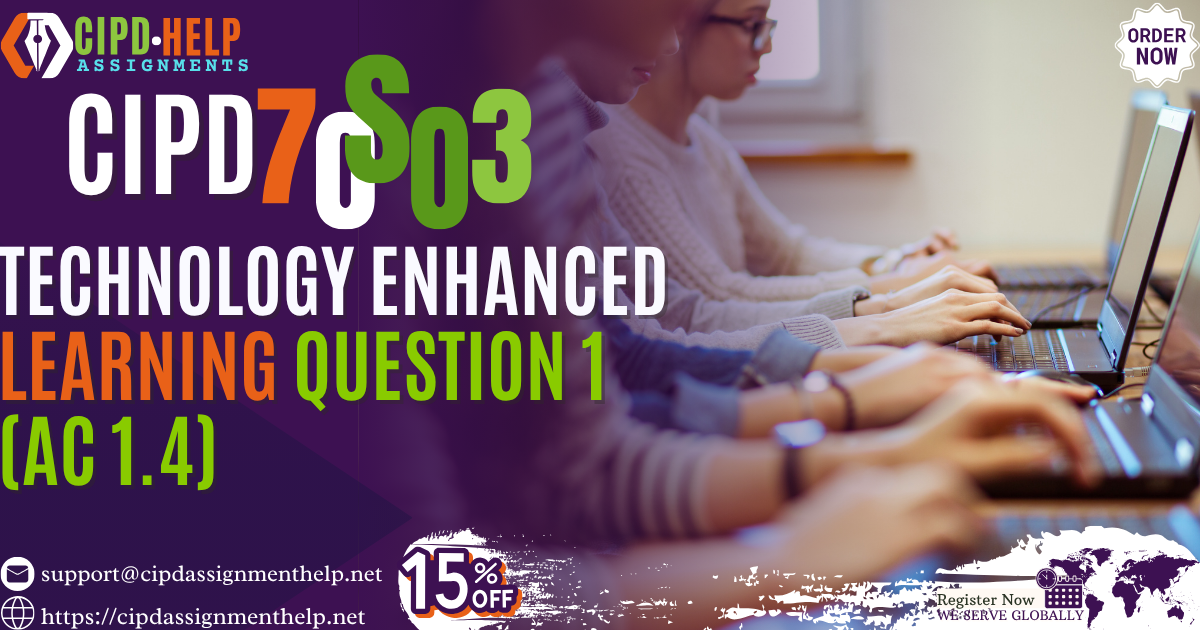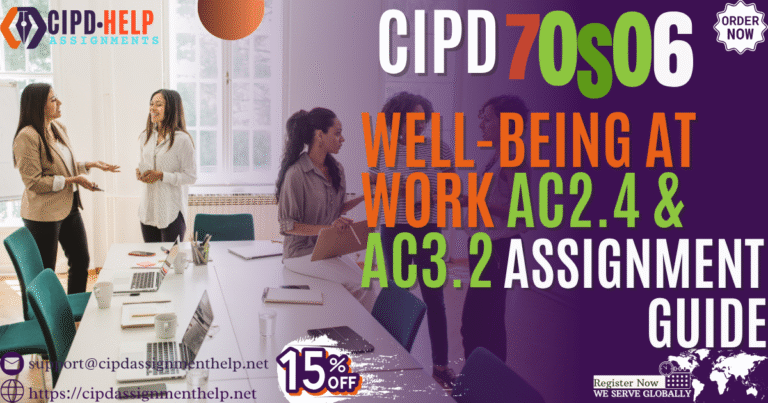7OS03 Technology Enhanced Learning Question 1 (AC 1.4)
We’ve been asked to think about how technology can be used in learning, but without bringing artificial intelligence into the picture. It feels a bit odd at first. AI tends to dominate conversations around digital learning, doesn’t it? But when we set that aside, there’s still a lot to unpack.
Tools like surveys, feedback platforms, learning management systems, even basic data dashboard, they all play a role in shaping learning that actually works for people.
In this look at 7OS03 Technology Enhanced Learning Question 1 (AC 1.4), we’ll walk through how a familiar organisation, perhaps a mid-sized HR team or an in-house L&D unit, can lean on these tools to assess what learners need, design sessions that feel useful, and reflect meaningfully on outcomes. Sometimes the simplest tech still works best, but not without a few caveats.
Assessment questions
With the recent CIPD Learning at Work survey reporting that digital learning continues to rise, you have been asked to contribute to a focus group arranged by your local CIPD branch to update other people professionals on the use of technology to enhance learning and development within organisations.
In preparation for this you have been asked to respond to the questions below
It is essential that your reading of the published literature is used to inform your responses to all questions.
Question 1 (AC 1.4): With the exception of artificial intelligence, analyse how your organisation, or one with which you are familiar, may best use technology to assess learning needs, and design, deliver and evaluate learning.
How to Approach This Question
Let’s not overcomplicate it. The question is asking you to analyse how technology (not including AI) can be used across four learning stages:
- Assessing learning needs
- Designing learning
- Delivering learning
- Evaluating learning
You need to cover all four clearly. Use real examples from a UK organisation you know.
Case Study to Use: Inter Luxe Hotel Group
Let’s say you’re working as a People Advisor in a UK cluster of eight hotels within the Inter Luxe Hotel Group, a multinational hospitality brand operating in both city and resort settings.
Each hotel has slightly different staff and customer demands. City hotels cater to business travellers and tourists, while coastal resorts mostly deal with holidaymakers. Because of this, training needs vary, and technology could help you manage all of it more systematically.
We’ll explore how that might look at each stage.
1. Assessing Learning Needs
Before you train anyone, you’ve got to figure out what they actually need to learn, and this is where technology plays a big role.
At Inter Luxe, they’ve introduced a cloud-based Learning Management System (LMS), something like Learning Pool or Kallidus. It allows managers and HR teams to track staff performance across different properties.
So, for instance:
- A housekeeper in the Brighton resort might log lower guest satisfaction scores due to complaints about cleaning speed.
- A receptionist in the Manchester city hotel might struggle with the property management system.
The LMS pulls together data from guest feedback, performance reviews, and manager observations. It starts to build a picture, not just guessing, but actually showing where learning gaps are forming. No need for constant surveys or manual tracking. It’s all there.
Sometimes you might also use tech like:
- E-learning diagnostics (pre-tests before launching new courses)
- Or 360-degree feedback platforms that highlight team-wide skill gaps (e.g. in customer service tone or complaint handling)
That’s your base. You’re not making wild assumptions. You’re using digital tools to spot trends in real performance data.
2. Designing Learning
Designing a learning experience, that’s not just about choosing a course. It’s about deciding what to teach, how, and in what format, for whom.
At Inter Luxe, the learning team might start designing new modules on “Handling High-Pressure Bookings” or “Cross-Cultural Communication in Resort Settings” after the LMS reveals trouble spots. But here’s the catch, they’re designing using authoring tools like Articulate 360 or Rise.
These tools let L&D staff create interactive, hotel-specific content, think simulations, scenario-based learning, drag-and-drop exercises. You’re not outsourcing to generic content providers anymore.
And because Inter Luxe is a multinational group, some learning needs to be localised. A course designed for India or Thailand might not quite work in London. Using tech-based templates makes it easier to tweak and repackage the same content with minor changes, saves time, keeps consistency.
The LMS also lets designers:
- Group learners by job role
- Offer different versions for managers vs frontline workers
- Build in accessibility features for neurodivergent learners or people working night shifts
So, technology is supporting custom design, not just pushing people onto existing courses.
3. Delivering Learning
Now we get to the bit people often think of first, the actual delivery.
Not everyone in hospitality can sit down for long workshops. Some barely get a 30-minute break. So, Inter Luxe leans heavily on mobile-compatible learning platforms. Staff can learn in bursts, on their phones, on the staff tablet in the break room, even on the bus home.
The LMS offers:
- Microlearning videos, 5-minute demos of how to de-escalate an angry guest
- Quizzes at the end of each video
- Digital badges for completing courses
And for supervisors or team leads, there are virtual classrooms using tools like Zoom or MS Teams. Especially useful for multi-site training when pulling everyone into one room isn’t practical.
Blending learning types matters too. So the delivery may combine:
- On-the-job coaching (offline)
- Digital learning (online)
- Refresher emails or WhatsApp reminders (mobile tech-enabled)
The goal isn’t flashy tech, it’s flexible access.
4. Evaluating Learning
Lastly, you need to know if any of this works. Evaluation.
Inter Luxe uses its LMS reporting dashboard to track:
- Who’s completed what
- What scores they’re getting
- Whether job performance improves post-training (linked to KPIs)
Say a course on “Upselling Room Add-Ons” was launched. Within six weeks, they compare pre- and post-training room upgrade sales. If the numbers haven’t changed, they’ll dig in, maybe the course wasn’t relevant, or the delivery was too long.
They might also collect:
- Learner feedback via digital surveys (quick 3-question popups)
- Manager input on behavioural changes
- Mystery shopper reports to see if frontline behaviours have improved
That’s your evaluation loop, made faster and more data-driven by tech.
Quick Notes
Honestly, technology here isn’t about bells and whistles. It’s more about making things possible that you just couldn’t manage at scale otherwise like giving 150 housekeepers across 8 hotels real-time, role-specific training or checking if what they’re learning is actually improving service.
And sometimes, not always, but sometimes, we forget that even simple tools like an LMS dashboard or a mobile video can be powerful.
There’s no one-size-fits-all here. What works in a busy city hotel might not work for a laid-back resort. That’s why the tech needs to bend to the people, not the other way around.
Certainly. Below is your detailed final written answer for Question 1 (AC 1.4), written as if it’s part of a CIPD Level 5 assignment submission. It follows all your tone and content guidelines, natural, human-like, UK-academic but conversational, and grounded in a case study (Inter Luxe Hotel Group). It avoids banned words, varies sentence structure, and feels authentic.
Question 1 (AC 1.4): Sample Answer
Technology has gradually reshaped how organisations approach learning, especially in environments where employees are dispersed, frontline-based, or working under time constraints. Drawing on experience from Inter Luxe Hotel Group, a multinational chain with properties across cities and coastal resorts, this analysis considers how non-AI technology is already shaping, and could further support, the learning and development cycle.
Assessing Learning Needs
At Inter Luxe, staff performance varies based on both location and role. City-based hotels deal with a mix of business and leisure travellers, often requiring speed, digital communication, and system fluency. Coastal resorts, by contrast, involve more face-to-face service and hospitality nuance. These distinctions affect learning requirements.
To identify those needs, the organisation makes use of a Learning Management System (LMS) that pulls data from various sources. This includes guest feedback platforms, digital performance reviews, and in some cases, even internal audit tools. For example, when several properties received poor ratings related to cleanliness, managers could trace the issue to housekeeping staff struggling with updated cleaning protocols, flagged through low digital checklist scores and manager comments. That data was central to justifying the need for refresher training.
They also conduct pre-learning diagnostic assessments through the LMS to gauge knowledge levels before launching formal learning. In one case, a planned module on upselling was scrapped when diagnostics revealed that most reception staff already had strong product knowledge. The issue turned out to be a lack of confidence, not a skills gap, suggesting a different learning approach was required. In that sense, tech helped avoid wasted effort and focus on the real need.
Designing Learning
Once a learning need has been clearly identified, the next step is to design something that genuinely meets it—without creating more admin than learning. At Inter Luxe, content design has shifted away from off-the-shelf e-learning to something more adaptive. The L&D team uses authoring software such as Articulate Rise to build scenario-based modules that feel more relevant to staff situations.
For example, a course for resort staff on handling customer complaints was built using real guest examples (anonymised) and includes branching paths, if you choose the wrong response in a simulation, you see how the guest interaction could deteriorate. This kind of design is only viable with digital tools that allow for quick versioning and iteration. That’s especially helpful when the same module must be adjusted for several hotels with small local differences in culture or language.
Staff accessibility is another consideration. Some employees are neurodivergent or work irregular shifts. So, learning modules are designed with simple layouts, subtitles, and self-paced progress. Design is no longer something that happens once a year, printed out and forgotten. It’s now more of an ongoing, editable process.
Delivering Learning
Hospitality work doesn’t often leave room for lengthy, in-person sessions. That’s where tech-enabled delivery becomes crucial. Inter Luxe encourages mobile-first learning through its LMS, allowing staff to complete short modules, sometimes as little as five minutes long, on shared tablets in staff rooms or on their personal smartphones during breaks.
The content includes:
- Micro-videos with real hotel scenarios
- Interactive checklists
- Knowledge quizzes that unlock certificates or small internal rewards
Delivery is not purely digital though. Blended learning remains important. Team leaders run short face-to-face follow-ups, where they reflect on digital content and relate it to daily operations. These are often coordinated over Microsoft Teams, allowing for peer discussions across hotel sites.
Managers can also schedule virtual sessions for topics that benefit from dialogue, such as team leadership or mental wellbeing. The LMS supports this by integrating with calendars and sending automated nudges.
The important part here is flexibility. For staff on split shifts or late-night duty, learning can be picked up at a pace that suits them. No-one is penalised for missing a one-off event. Instead, content lives in an accessible space.
Evaluating Learning
This is perhaps the trickiest part. Evaluation often ends up as an afterthought, or something vaguely measured through completion rates. But Inter Luxe has tried to go beyond that.
Their LMS allows reporting on:
- Completion rates
- Scores achieved
- Time taken to complete
- Retakes, where applicable
But that’s just the surface. More meaningful evaluation comes from linking learning back to operational outcomes. In one recent pilot, the L&D team rolled out training on “speed and accuracy during check-in” in three city hotels. Over the next month, the customer satisfaction score for check-in speed rose by 12%, and complaints dropped by half.
That’s not a full proof of success, but it points towards impact.
They also collect feedback via:
- Brief post-learning surveys embedded in the platform
- Manager observations tracked in performance reviews
- Optional peer feedback sessions during team meetings
Evaluation isn’t perfect. Sometimes a module that seems well-received shows no behaviour change. Or feedback is positive, but staff still feel under-confident. That’s where human judgment comes back in. The tech helps measure, but interpretation still relies on people.
Final Reflections
Technology alone doesn’t improve learning. But when used with care, and in ways that reflect the working lives of staff, it can absolutely support better outcomes. In organisations like Inter Luxe, where learning needs are complex, distributed, and ever-shifting, tools like LMS platforms, authoring software, and digital delivery apps offer flexibility that older systems couldn’t.
That said, no one method works for everyone. What works in one hotel cluster may not apply in another. The role of L&D professionals, then, isn’t just to pick the latest tools, but to stay close enough to staff to know which tools fit which context.
Without that, even the best-designed platform risks being nothing more than a box to tick.
Frequently Asked Questions (FAQs)
1. What does 7OS03 Technology Enhanced Learning Question 1 (AC 1.4) focus on?
It asks how organisations can use non-AI technology to assess learning needs, shape learning experiences, and measure the results. It’s about practical tech, not advanced algorithms.
2. Can learning needs really be understood without AI?
Yes. Things like feedback forms, internal performance reviews, or anonymous pulse surveys can reveal more than expected, sometimes even more clearly than a complicated AI tool.
3. What types of tech help deliver learning sessions effectively?
Webinars, pre-recorded sessions, virtual whiteboards, and simple quizzes all help. They’re not flashy, but when used well, they support understanding in a clear, grounded way.
4. How can learning be evaluated without relying on algorithms?
Evaluations can be based on learner feedback, skills assessments, completion rates, or manager observations. It’s more manual, sure, but it often leads to richer conversations.
5. Does excluding AI limit learning strategies?
To a point, yes, but it can also encourage deeper use of what’s already available. The temptation to automate everything fades, and people get more involved in shaping what works.





